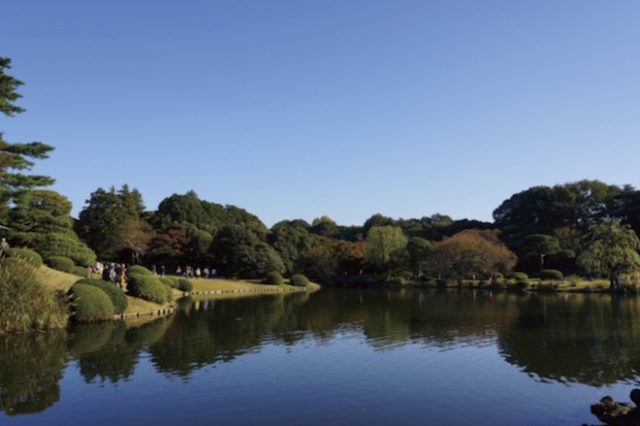By Yukiko Tanaka
The land on which Shinjuku Ward stands is roughly square in its shape. At Shinjuku Station (for JR and two private lines as well as subways), Shinjuku-dōri becomes Koshu-kaido, which was one of Edo’s highways.
In fact, a posting station called Naito Shinjuku, or Niijuku, was there. As the name suggests (‘Nii’ means new), it was a relatively new posting station but it was at this spot that the Edo suburb met the rural. And, being a posting station, there were inns, fifty or so, along with restaurants and teahouses; waitresses who worked in those establishments prostituted themselves, a common practice of those days. I wonder if a kind of vulgarity long-associated with Shinjuku, particularly Kabuki-cho, is not unrelated to this history.
On the other hand, there is Shinjuku Gyoen, a five minutes’ walk from Shinjuku Station. It is a wonderful expanse of open space, a few ponds, formal gardens—traditional Japanese and English, as well as a large conservatory. This space with twenty thousand trees in it was once an estate that belonged to the Naito Domain. Shinjuku Gyoen belonged to the imperial household until the end of the Pacific War and today it is open to the public, although, unlike several parks in Central Tokyo, is not under the municipal government’s management and so one has to pay a nominal fee to get in.
So vast is Shinjuku Gyoen garden that you cannot hear the noise of the busy streets surrounding it. You can enjoy moments of tranquility in this inner-city oasis, but you can also see people taking a stroll, painting or sketching while some come here to have a picnic or eat lunch and others come to take a nap. As long as you do not see the tops of buildings in the distance, you forget that you are in the mega-city of Shinjuku.
Shinjuku saw its development at first during the time of Japan’s high economic growth during the 1960s and ‘70s. It has grown in size since then with two private rails, the Odakyu and Keio Lines, extended further westward, transporting people from the suburbs back and forth. Along with commuting workers and students, Shinjuku Station saw people who came to shop at one of three main department stores, two of which are in the station compound. The number of people going through the Shinjuku Station, I heard, has been the largest of all Asian cities.
During the 1960s, when I was in college, Shinjuku was already a busy urban center, and there were many stores, cafes and restaurants along with a few movie theaters lining major thoroughfares and many side streets. The young–and not so young–spent a great deal of time here in coffee houses among others. Coffee and tea houses, or kissaten, served a particular function for those living in distant suburbs or nearby but too tiny houses, ‘rabbit hutches’ as deemed by US media. Kissaten were the living room for them to relax in, to meet people or to conduct businesses. College students spent hours with a cup of coffee, the price of which was actually for the convenience and a comfortable space.
The late 1960s was a highly political era in Japan, as elsewhere, for mobilizing students and other young people into the streets, in which Shinjuku was no exception. There were ‘hippies’ and along with them were folk music and underground theaters in so-called fo-ku kissa, or folk coffee/tea houses, where people sang popular songs together. Shinjuku then represented the anti- establishment, and such terms as futen (f ree souls of wonderers) or harenchi (shameless and daring) were heard on its streets. In 1969, a large folk song assembly was held at the open space inside Shinjuku Station compound, and when it became too wild, the police force was mobilized. The era of Shinjuku seems to have ended with this incident.
[Editor’s Note]
This series introduces a historical view of various sites in Tokyo. The writer can be reached at ytanaka03@gmail.com.







